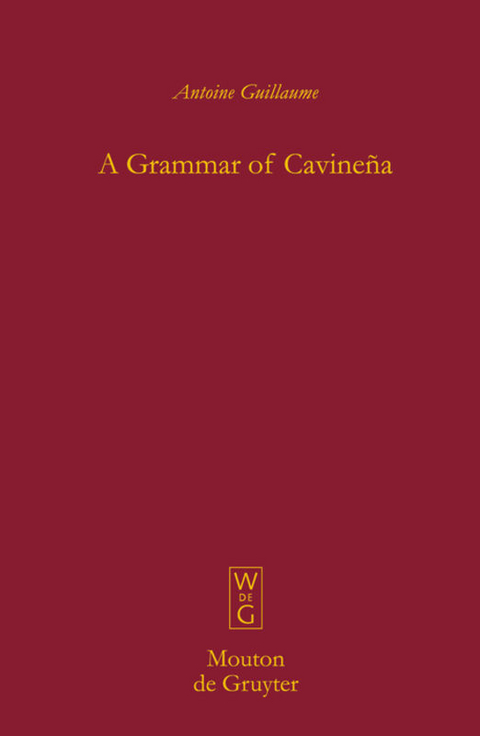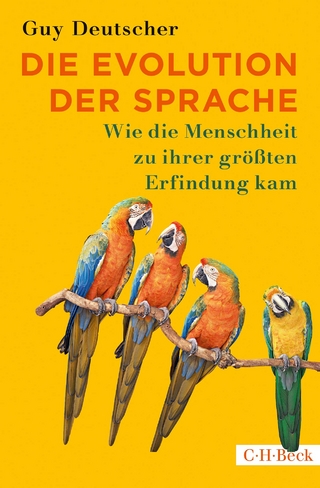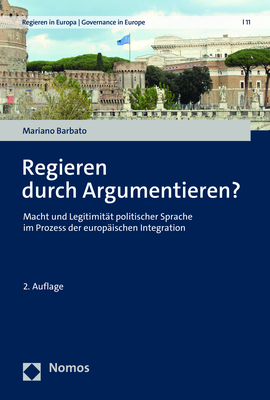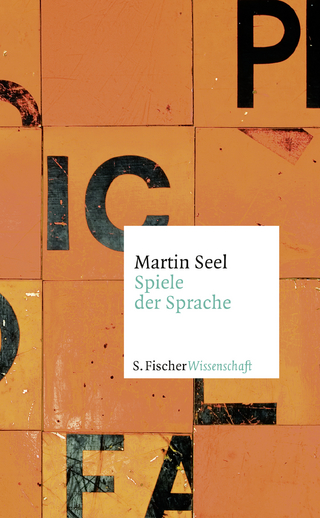
A Grammar of Cavineña
de Gruyter Mouton (Verlag)
978-3-11-018842-4 (ISBN)
This book is a detailed high-quality descriptive grammar of the endangered Cavineña language (less than 1200 speakers), spoken in the Amazonian rainforest of Lowland Bolivia, an area where the indigenous languages are virtually unknown. Cavineña belongs to the Tacanan family, comprising five languages, none of which has been the subject of an adequate descriptive grammar. The grammar is based mostly on the extensive fieldwork conducted by the author in traditional Cavineña communities. Cast in the functional-typological framework, and based on natural discourse data, the grammar presents a detailed and copiously exemplified account of most aspects of the language, building up from basic levels (phonetic and phonological) to higher levels (morphological and syntactic), and from brief descriptions of each level to a more comprehensive description of the same level in specific chapters. The language contains a number of unusual features that will be of interest to typologist linguists, such as an unusual pitch accent system, a morpho-phonological rule that deletes case markers, an intricate predicate structure, a system of verbal suffixes coding associated motion, a specific causative of involvement marker, a peculiar prefix e- that attaches to nouns coding body parts and a complex system of second position clitic pronouns. The grammar will also be of interest to historical-comparative linguists, as for the first time one has sufficiently detailed grammatical information to make possible a reliable comparison with other languages with which Tacanan languages might be related, in particular the Panoan family, and to serve as input into hypotheses regarding the population history of this part of South America.
Antoine Guillaume, CNRS & Université Lumière Lyon 2, France.
Contents
List of plates
List of tables xvii
List of abbreviations xx
Summary xxii
Acknowledgments xxiv
Maps xxvi
1 The language and its speakers 1
1.1. Geographic location 1
1.2. Sociolinguistic situation 3
1.3. Physical environment, subsistance and culture 4
1.4. History 6
1.5. Genetic affiliation 8
1.6. Bibliographic review 9
1.7. Fieldwork 12
1.8. Corpus 15
1.9. Linguistic type 17
1.10. Writing systems 19
Appendix to chapter 1 - List of example codes 20
2 Phonology 26
2.1. Consonants 26
2.1.1. Inventory 26
2.1.2. Phonetic realisations 27
2.1.3. Minimal pairs 30
2.2. Vowels 31
2.2.1. Inventory 31
2.2.2. Phonetic realisations 31
2.3. Foreign sounds 33
2.4. Syllable structure 34
2.5. Phonotactics 35
2.6. Justifying analytic choices 36
2.6.1. Complex consonants 36
2.6.2. Vowel sequences 38
2.6.3. Glides 39
2.7. Morpho-phonology 40
2.7.1. Palatalisation 41
2.7.2. Vowel deletion 41
2.7.3. Syllable deletion 41
2.7.4. Suffix deletion 42
2.7.5. Clitic deletion 43
2.7.6. Vowel addition 43
2.8. Accentual system 44
2.9. Intonation 45
2.9.1. Utterance-final contour 45
2.9.2. Emphatic contour 47
2.9.3. Intensifier contour 47
2.10. Previous writing systems 48
3 Grammatical vs. phonological word 51
3.1. Criteria for grammatical vs. phonological word 51
3.1.1. Grammatical word 51
3.1.2. Phonological word 53
3.2. Mismatch between grammatical and phonological words 54
3.2.1. One phonological word = two (or more) grammatical words 54
3.2.2. One grammatical word = two phonological words 56
3.3. Mono-syllabic grammatical words 57
3.4. When a phonological word only consists of clitics 59
4 Grammatical overview 61
4.1. Word classes 61
4.2. Predicate and verbs 62
4.2.1. Predicate structure 63
4.2.2. Verbs 66
4.3. Predicative adjectives 67
4.4. Noun phrase - nouns and NP modifiers 69
4.4.1. NP structure 69
4.4.2. Nouns 71
4.4.3. Attributive adjectives 73
4.4.4. Number markers 73
4.4.5. Quantifiers 74
4.5. Remaining word classes 75
4.5.1. Postpositions 75
4.5.2. Pronouns 76
4.5.3. Demonstratives 80
4.5.4. Content question words 81
4.5.5. Particles 82
4.5.6. Subordinate clause markers 86
4.5.7. Interjections 87
4.5.8. Onomatopoeia 89
4.6. Main clause structure 91
4.6.1. Basic clause structure 91
4.6.2. S, A and O grammatical functions 94
4.6.3. Copula clauses 96
4.6.4. Imperative and hortative clauses 100
4.6.5. Interrogative clauses 102
4.6.6. Negative clauses 105
4.7. Dependent clauses 108
4.8. Coordination 110
4.8.1. Conjunction 110
4.8.2. Disjunction 114
5 Predicate structure - an overview 117
5.1. Structure of the predicate 118
5.1.1. Slots A/K: inflectional affixes 119
5.1.2. Slot B: preverbal modifiers 121
5.1.3. Slot C/G: valency-changing affixes 121
5.1.4. Slot D: verb root 122
5.1.5. Slot E: auxiliary 123
5.1.6. Slot F: postural and directional suffixes 124
5.1.7. Slot H: aktionsart suffixes 125
5.1.8. Slot I: mode markers 127
5.1.9. Slot J: postverbal modifiers 127
5.2. Inflecting verbs 128
5.2.1. Basic inflecting verbs 128
5.2.2. Verbalisation of nouns 131
5.2.3. Verbalisation of adjectives 133
5.2.4. Verbalisation by reduplication 140
5.2.5. Noun incorporation 143
5.2.6. Formatives 146
5.3. Non-inflecting verbs 148
5.3.1. Basic non-inflecting verbs 148
5.3.2. Borrowings 149
5.3.3. Direct conversion 151
5.3.4. Inherent reduplication 154
5.3.5. Lexicalisation 155
5.3.6. Transitivity 155
5.4. Justifying the complex predicate analysis 157
5.5. Reduplication 160
6 Predicate structure - inflectional morphology 162
6.1. TAM inflections 163
6.1.1. -kware 'REM.PAST' and -chine 'REC.PAST' 163
6.1.2. -buke 'REM.FUT' 165
6.1.3. -ya 'IMPFV' 167
6.1.4. -wa 'PERF' 172
6.1.5. e-...-u 'POT' 175
6.1.6. Verb with no inflectional marking 176
6.2. Imperative, hortative and jussive inflections 179
6.2.1. Imperative inflections 179
6.2.2. Hortative inflections 184
6.2.3. Jussive inflection 186
6.2.4. Negating verbs with hortative and jussive inflections 186
6.2.5. Non-command meanings 187
6.2.6. Markedness and historical considerations 188
7 Predicate structure - Aktionsart suffixes 190
7.1. Aktionsart suffixes of aspect/manner 191
7.1.1. -tere / -tirya 'COMP' vs. -bisha 'INCOMP' 191
7.1.2. -jaka 'STOP' vs. -tibune 'START' 194
7.1.3. -jeri/-neri 'ALMOST' 196
7.1.4. -nuka 'REITR' 198
7.1.5. -baka 'SHORT' vs. -siri 'LONG' 200
7.1.6. -wisha 'FAST' 202
7.1.7. -bare 'DISTR' 203
7.1.8. -(ne)ni 'RANDOM' 206
7.1.9. Last syllable reduplication + causative 210
7.1.10. -aje/-be/-etibe 'INCR' 213
7.2. Aktionsart suffixes of motion (S/A-oriented) 217
7.2.1. System description 218
7.2.2. Intended vs. incidental motion 224
7.2.3. Foregrounded vs. backgrounded motion 228
7.2.4. Corresponding verbs 232
7.2.5. 'Leave' and 'arrive' 233
7.2.6. S/A-orientation 234
7.3. Aktionsart suffixes of motion (O-oriented) 235
7.4. Aktionsart suffixes of time of day 239
7.5. Aktionsart suffix of emotion 243
7.6. Distribution 248
7.7. Suffixes vs. compounded/serialised verbs? 254
8 Predicate structure - valency-changing mechanisms 257
8.1. Passive derivation 258
8.2. Reflexive derivation 270
8.2.1. Reflexive and reciprocal functions 272
8.2.2. Benefactive reflexive 274
8.2.3. Patientless reflexive 277
8.2.4. Miscellaneous 279
8.3. Antipassive derivations 281
8.3.1. Full reduplication 282
8.3.2. Exchanging auxiliaries 286
8.4. Causative derivations 290
8.4.1. Causativiser of intransitive verbs -sha 291
8.4.2. Causativiser of transitive verbs -mere 297
8.4.3. Causative of involvement -kere 303
8.5. Distribution 308
9 Predicate structure - postural and directional suffixes 313
9.1. Postural suffixes 313
9.1.1. -ani 'SIT' 314
9.1.2. -neti/-nitya 'STAND' 316
9.1.3. -jara 'LIE' 318
9.1.4. -bade 'HANG' 319
9.2. Directional suffixes 320
9.2.1. -tsura 'GO UP' 321
9.2.2. -bute/-butya 'GO DOWN' 323
9.2.3. -sikwa 'GO AWAY' 325
9.2.4. S/O-orientation 327
9.3. Distribution 327
9.4. Suffixes vs. compounded/serialised verbs? 329
10 Predicate structure - auxiliary-taking processes 330
10.1. Auxiliary-taking suffixes 331
10.1.1. -kara/-karama 'DESID' 331
10.1.2. -metse 'FIRST' 334
10.1.3. -jakama 'CEASELESSLY' 335
10.1.4. bawe 'ALWS' and baekwa 'ALWS.NEG' 336
10.1.5. ki / aki 'TYPICAL' 340
10.2. Auxiliary-taking preposed markers 343
10.2.1. nere 'VIGOROUSLY' 343
10.2.2. yume 'IMMEDIATELY' 344
10.2.3. riya 'STARTLING' 346
10.2.4. pana 'PROPERLY' 346
10.2.5. Miscellaneous 347
10.3. Auxiliary-taking discontinuous marker 348
10.4. Auxiliary-taking postposed markers 352
10.5. Auxiliary-taking Ø-marker 353
10.6. Full reduplication 360
10.7. Combination of two auxiliary-taking processes 364
10.8. Combinations with other verbal categories 364
11 Predicative adjectives 369
11.1. Syntax 370
11.1.1. Copula complement 370
11.1.2. Modifier dyake 'very' 372
11.1.3. Attributive function strategies 372
11.1.4. Adverbial function 373
11.1.5. Secondary predicate function 377
11.2. Da-adjectives 380
11.2.1. Dummy suffix -da/-u 'ASF' 381
11.2.2. Reduplication 383
11.2.3. Interrogative prefix eje- 'INT' 385
11.2.4. Negative suffix dama 'NEG' 387
11.2.5. Compounding 389
11.2.6. Augmentative -si 'AUGM' 393
11.2.7. Direct conversion 396
11.3. Independent adjectives 400
11.3.1. Adjectivisation of nouns by ki 'WITH' and ma 'WITHOUT' 401
11.3.2. Adjectivisation of nouns by full reduplication 405
11.3.3. Adjectivisation of verbs by -taki 'ABIL' 406
11.3.4. Adjectivisation of verbs by e 'RES' and -ma 'RES.NEG' 411
11.3.5. Miscellaneous 414
Appendix 1 to Chapter 11 - list of da adjectives 416
Appendix 2 to Chapter 11 - list of independent adjectives 419
12 Noun phrase structure - an overview 421
12.1. NP structure - overview 421
12.2. Nouns - overview 425
12.3. E-nouns 425
12.3.1. Prefix formative e 'NPF' 425
12.3.2. Irregularities 429
12.3.3. Semantics 432
12.4. Kinship nouns 434
12.4.1. Semantics 434
12.4.2. Possessor inflections 435
12.4.3. Kinship nouns and genitive modifier (slot C) 438
12.4.4. Kinship nouns and =kwana 'PL' 439
12.4.5. Irregular kinship nouns 439
12.5. Independent nouns 440
12.5.1. Semantics 441
12.5.2. Semantic overlaps with e nouns and kinship nouns 442
12.5.3. Interrogative noun ai 'INT' 444
12.5.4. Deictic nouns 445
12.6. Grammar of inalienability 447
12.7. Derivational morphology 449
12.7.1. -puji 'ONE THAT' 450
12.7.2. e-...-ki 'NMLS' 452
12.7.3. e-...-kware 'NMLS' 454
12.7.4. -kini 'PLACE' 455
12.7.5. -chi 'AFFTN' 456
12.7.6. Direct conversion 457
12.7.7. Reduplication 461
12.7.8. Formatives 464
Appendix to chapter 12 - list of e-nouns 467
13 Noun phrase structure - modifiers 469
13.1. Noun juxtaposition (slot D) 469
13.1.1. Syntax 470
13.1.2. Semantics 473
13.1.3. Lexicalisation 478
13.1.4. Juxtaposition vs. compounding 479
13.2. Attributive adjectives (slot F) 480
13.2.1. Syntax 481
13.2.2. Semantics 482
13.2.3. Compounding? 490
13.3. Number markers (slot G) 492
13.3.1. Syntax 492
13.3.2. Semantics 498
13.4. Genitive modifier (slot C) 501
13.4.1. Syntax 501
13.4.2. Semantics 504
13.4.3. Genitive modifier vs. juxtaposed noun 506
13.5. Quantifiers (slot B) 508
13.6. Relative clause modifier (slots A or H) 515
13.6.1. Syntax 516
13.6.2. RC preposed to the head 519
13.6.3. Semantics 525
14 Postpositions 526
14.1. Morpho-syntactic introduction 526
14.2. =tsewe 'ASSOC' 529
14.2.1. Semantics 529
14.2.2. Pro-forms 532
14.3. =ja 'DAT' 533
14.3.1. Semantics 534
14.3.2. Pro-forms 536
14.3.3. Dative vs. genitive 537
14.4. =ju 'LOC' 538
14.4.1. Semantics 538
14.4.2. Pro-forms 541
14.5. =keja 'LOC.GNL' 544
14.5.1. Semantics 544
14.5.2. Pro-forms 546
14.5.3. Increment -amaka 549
14.6. =eke 'PERL' 550
14.6.1. Semantics 551
14.6.2. Pro-forms 555
14.6.3. Increment -amaka 557
14.7. =tupu 'UP.TO' 558
14.7.1. Semantics 558
14.7.2. Pro-form 559
14.8. Minor postpositions 560
14.8.1. ji(/e)teke 'LOOKING FOR' 561
14.8.2. Quantifer postpositions 563
14.8.3. =kama 'ONLY' 565
14.8.4. =taka 'ALONE' 566
14.9. Postpositions with optional argument 568
14.9.1. General overview 568
14.9.2. 'On' vs. 'under' 573
14.9.3. 'Inside' vs. 'outside' 575
14.9.4. 'Behind', 'further behind' and 'following' 576
14.9.5. 'At the corner of' 578
14.9.6. 'At the side of' 579
14.9.7. 'At the edge of' 579
14.9.8. 'In the middle of' 581
14.9.9. 'Close to' 582
15 Pronouns and demonstratives 584
15.1. Independent pronouns 585
15.1.1. Syntax 585
15.1.2. Morphology 588
15.2. Bound pronouns 593
15.2.1. Syntax 594
15.2.2. Morphology 596
15.2.3. Principles of bound pronoun ordering 603
15.2.4. Ordering restrictions 606
15.3. Bound pronouns vs. independent pronouns/NP 611
15.3.1. A function 611
15.3.2. S/O function 616
15.3.3. DAT function 622
15.4. Number 623
15.5. 3PROX pronouns 624
15.6. Ekatse '3DL' and ekana '3PL' 627
15.7. Adverbial demonstratives 631
15.7.1. Deictic function 631
15.7.2. Case distinctions 635
15.7.3. Anaphora 636
15.8. Pointing demonstratives 636
15.8.1. Deictic function 636
15.8.2. Morpho-syntactic properties 639
15.8.3. Additional functions 639
15.8.4. Nominal demonstrative strategies 642
15.8.5. Conjunction 643
16 Particles - independent, first position and second position particles 645
16.1. Independent particles 645
16.1.1. Introduction 645
16.1.2. datse 'FRUST' 647
16.1.3. amena 'FILL' 649
16.2. First position particles 651
16.2.1. Introduction 651
16.2.2. are 'QUEST' 652
16.2.3. ita 'ATT.GETTER' 653
16.2.4. deka 'POTENTIALLY' 654
16.2.5. masa 'SEEMINGLY' 655
16.2.6. jipakwana 'SEEMINGLY.NOT' 656
16.2.7. jipake 'LUCKILY' 657
16.3. Second position particles 657
16.3.1. Introduction 657
16.3.2. =ni 'MAYBE' 658
16.3.3. =tukwe 'COUNT.EVID' 660
16.3.4. =pa 'REP' 662
16.3.5. =di(dya) 'STRG.EMPH' 667
16.3.6. =jatsu 'EXACTLY' 669
16.3.7. =taa 'EMPH' 670
16.3.8. =bakwe 'CONTR' 673
16.3.9. =shana 'PITY' 675
16.3.10. Distribution 676
17 Particles - phrasal particles 679
17.1. Introduction 679
17.2. =jari 'STILL' 681
17.3. =nuka 'REITR' 684
17.4. =dya 'FOC' 686
17.5. =kwita 'RESTR' 689
17.6. =kamadya 'ONLY' 691
17.7. =tere 'ONLY' 695
17.8. =piisi 'JUST' 696
17.9. =dyane 'APPROX' 697
17.10. =ama 'NEG' 698
17.11. ni= 'NOT.EVEN' 703
17.12. =piji 'DIM' 704
17.13. =ebari 'INTENS' 708
17.14. =jutidya/jutii 'DISEMPH' 710
17.15. =jipenee 'ALMOST' 713
17.16. =kwana 'UNCERT' 714
17.17. Distribution 717
18 Non-finite adverbial clauses 720
18.1. Morpho-syntactic introduction 720
18.1.1. Finiteness 720
18.1.2. Subordination 721
18.2. Same subject temporal clause 723
18.2.1. Function 723
18.2.2. Same subject co-reference 727
18.3. General purpose clause 728
18.3.1. Function 729
18.3.2. Structure 732
18.3.3. Headless general purpose clauses 734
18.3.4. Nominalisation? 736
18.4. Purpose of motion clause 737
18.4.1. Function 737
18.4.2. Auxiliaries and copula 740
18.4.3. Miscellaneous 741
18.5. Minor non-finite adverbial clauses 742
18.5.1. Cause clause 742
18.5.2. 'Just before' clause 744
19 Finite adverbial clauses 746
19.1. Morpho-syntactic introduction 746
19.1.1. Finiteness 746
19.1.2. Subordination 748
19.2. Different-subject temporal clause 749
19.2.1. Semantics 749
19.2.2. 'Tail-head' linkage 752
19.2.3. Switch-reference 753
19.3. Reason clause 754
19.3.1. Semantics 754
19.3.2. Pro-forms 757
19.4. Similarity clause 757
19.4.1. Semantics 757
19.4.2. Pro-forms 761
19.5. Conditional clause 761
19.6. Minor finite adverbial clauses 764
19.6.1. =ademe 'THANKS TO' 764
19.6.2. Concessive clauses 766
19.6.3. Simultaneity clauses 769
20 Relative clauses 771
20.1. Structure of a relative clause (RC) 771
20.1.1. Finiteness 771
20.1.2. Copula RC 773
20.2. Ligature marker =ke 775
20.2.1. Ligature deletion rule 775
20.2.2. Ligature and plural marker 778
20.2.3. Ligature and 3rd person 'possessor' inflections 780
20.3. Statement of common argument (CA) 781
20.3.1. CA in MC not in RC 781
20.3.2. CA in RC not in MC 785
20.3.3. CA neither in MC nor in RC 787
20.3.4. Ambiguity 789
20.4. CA functions in MC and in RC 789
20.5. RC functions 791
20.5.1. Restrictive RC 791
20.5.2. Non-restrictive RC 791
20.5.3. 'Tail-head' linkage 792
20.6. Grammaticalisation of RCs into adverbial clauses 794
20.6.1. RC relating to core argument 794
20.6.2. RC vs. DS-temporal clauses 796
Texts 798
Text 1 - When the Araonas became angry with each other 798
Text 2 - The woman who was eaten up by giant mosquitoes 824
References 827
Index
Lexicon
| Erscheint lt. Verlag | 15.7.2008 |
|---|---|
| Reihe/Serie | Mouton Grammar Library [MGL] ; 44 |
| Zusatzinfo | 2 b/w tbl., 5 photos. 2 maps |
| Verlagsort | Basel/Berlin/Boston |
| Sprache | englisch |
| Gewicht | 1555 g |
| Themenwelt | Schulbuch / Wörterbuch ► Wörterbuch / Fremdsprachen |
| Geisteswissenschaften ► Philosophie ► Sprachphilosophie | |
| Geisteswissenschaften ► Sprach- / Literaturwissenschaft ► Sprachwissenschaft | |
| Schlagworte | Bolivia • Bolivia; Latin America (language) • Bolivien • Hardcover, Softcover / Allgemeine und Vergleichende Sprachwissenschaft • HC/Allgemeine und Vergleichende Sprachwissenschaft • HC/Sprachwissenschaft, Literaturwissenschaft/Sonstige Sprachen, Sonstige Literat • Indianersprachen • Lateinamerika /Sprachen • Latin America (language) |
| ISBN-10 | 3-11-018842-2 / 3110188422 |
| ISBN-13 | 978-3-11-018842-4 / 9783110188424 |
| Zustand | Neuware |
| Haben Sie eine Frage zum Produkt? |
aus dem Bereich


